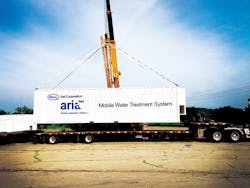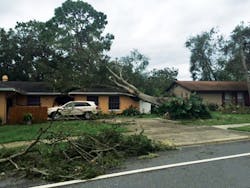Rapid Reaction
As Hurricane Harvey set its sights on Houston, municipal water and wastewater plants boarded up windows and prepared for heavy rainfall and strong winds, not knowing just how much damage the tropical storm would cause. Some of those plants hold hurricane contracts with manufacturers like Tsurumi Pumps, which moved equipment to its Dallas warehouse in advance of the storm to prepare for requested equipment replacement.
Glenn Wieczorek, managing director for Tsurumi America, said employees at Tsurumi Pumps keep a close eye on weather patterns, particularly those of hurricanes, to prepare inventory in case pumps need to be replaced.
“We have a couple people on staff that kind of take it upon themselves to just pay close attention to The Weather Channel,” Wieczorek said. “Sometimes, we’ll move equipment beforehand, and the storm moves in a different direction, so we have equipment moved in there that we don’t necessarily need. We prefer to do it that way and make a mistake from time to time. That way we’re more prepared for handling demand for trend users.”
In the case of Hurricane Harvey, the extent of damage was not clear until water receded below major flood levels two weeks after the hurricane first made landfall. With water so high, chemicals and raw sewage mixed with other debris in the water, leading to contamination concerns and at least one case of flesh-eating bacterial infection.
Cleaning up inundated plants will require pumping water and sewage out of them. Replacing failed pumps also is of concern, but Wieczorek said getting to the places that need help the most is the biggest obstacle.
“Until the water starts to recede, they’re really not going to be able to do a whole lot,” Wieczorek said one week after Harvey first made landfall. “When a disaster hits—whether it’s an earthquake, a tornado or a hurricane—a lot of times, the pathway to get to those facilities is obstructed so they can’t get in. So for instance right now in Houston, we just can’t get equipment in there. The only way that you’re going to be able to have a contingency plan is to have that equipment there.”
Some municipalities have emergency contingencies in place to get systems back up and running quickly. “They’ll rent tanks and pumps and get [process water] out of their treatment facility, get it into a temporary containment, clean it up, and then be able to get that back into their normal process and then start processing the waste once again,” Wieczorek said.
Pumping in a Disaster
When making a contingency plan, determining the type of pumps used in a plant is a must. Creating an action plan that does not consider loss of power when pumps are electrically driven or lack of fuel when they are engine-driven will not be effective. A strong plan will account for these shortcomings, Wieczorek said.
And different pumps serve different purposes during an emergency. In flooding situations, for instance, Wieczorek said high-pressure pumps may not be the best course of action, as they are designed for higher flow applications.
“What they’re doing right now is they’re scrambling around trying to get just about any pump they can, but they have to pay attention to the true configuration of that pump, and then again if they have electricity available, or if they have to rely solely on engine-driven pumps,” Wieczorek said. “In these situations, though, sometimes the best pump is the pump that’s simply available. Even if you have the wrong pump for the application, if it’s pumping a little bit of water, it’s better than having nothing. As we say in our business, when you’ve got water up to your knees, you just want somebody to take care of your problem.”
For Weiczorek, that anecdote hits close to home. His friend’s son lives in the Houston area, and his house was inundated with nearly 4 ft of water. That sense of helplessness for a homeowner, he noted, extends to operators, which makes delivering pumping equipment important.
Treatment plants monitor weather activity to prepare for major weather events.
Emergency Treatment
As the water is being moved around, much of it still needs to be treated, especially if equipment is in disrepair. Manufacturers such as Pall Water have found success with containerized units that fit on a trailer truck for emergency situations. Joe Swiezbin, director of technology for Pall Water, said the company’s mobile membrane units have been a saving grace for operators in a bind.
“As we’ve seen in Texas and in Florida, the flooding leads to water quality that can really be harmful,” Swiezbin said. “You want to have a system that will address the pathogens and also a system that will address organics in the water if there’s a gas spill or something like that.”
The units fit on a trailer truck so they can be quickly transported where they needed. And when they get to their destination, Swiezbin said they are “plug-and-play,” meaning the units simply need a power connection and the water to be treated to begin working. The units start by passing water through a microfilter to handle pathogens, and some units also include a reverse osmosis system to remove organic material, which Swiezbin said would be critical for treating water following sanitary sewer overflows.
He recalled a case in Wellsboro, Penn., where a conventional water system began to fail. It had high turbidity and algal growth, forcing the municipality to initiate a boil order. Pall Water brought in a mobile membrane unit to trial its effectiveness for the application. Swiezbin said the municipality purchased the unit and uses it as its primary filtration system.
“When you’re looking at solutions, they have to be easily installed and deployable,” Swiezbin said. “We’ve felt that these mobile systems provide that kind of relief after a natural disaster.” Like pumps, however, the systems require electricity to run. In the case of power outages, Swiezbin said operators should determine the appropriate generator for their needs, and prepare accordingly.
Complying With Discharge Limits
Texas Commission on Environmental Quality (TECQ) Executive Director Richard A. Hyde suspended environmental discharge rules three days after Hurricane Harvey made landfall. According to a TECQ press release from Aug. 28, Hyde suspended the rules “because they prevent, hinder or delay necessary action in coping with Hurricane Harvey.”
Among those rules suspended are the requirements to pass documentation and specific reports through TECQ during construction of facilities with bond proceeds, and the requirement to seek bids for work, which can be a lengthy process for a municipality already burdened by a disaster. Also suspended were effluent limitations for domestic wastewater and land disposal of sewage effluent.
Wieczorek said such suspensions make sense as some operators in the Houston area were likely unable to access their systems to monitor discharge limits.
“These are things that people just don’t think about,” Wieczorek said. “When the system works well, people aren’t thinking about the infrastructure of these systems, but in times like this, where it’s going to take them a while to get up and running and repair it and then have it inspected and making sure it is up to code is going to take a while.”
Seeing Double
Hurricane Irma followed in Harvey’s path. Irma was named the most powerful hurricane ever recorded in the Atlantic Ocean outside the Caribbean and Gulf of Mexico. With 185-mph winds, it started as a Category 5 hurricane, which is the most serious type of major hurricane on the Saffir-Simpson wind scale.
Hurricane Irma made landfall in the Caribbean Sept. 6 and hit Florida Sept. 10. The storm first hit Barbuda, but also affected other islands, including St. Martin, Antigua, Martinique, Puerto Rico and more. In the U.S., it moved northwest across Florida, devastating the Florida Keys, but eventually downgraded to a tropical storm with winds of 70 mph on Sept. 11. Jacksonville, Fla., experienced a storm surge that exceeded record levels. Other states felt Irma’s effects, including Georgia, Alabama, South Carolina, North Carolina and Tennessee.
Irma left behind destructive results. According to CBS, the death toll related to Irma stood at 69 on Sept. 14. ABC News reported that approximately 90% of homes in the Florida Keys sustained damage, and according to CNN, more than 6 million people in Florida alone were left without power.
As of press time, Hurricane Maria—a Category 4 hurricane—was expected to hit the still-recovering Caribbean.


